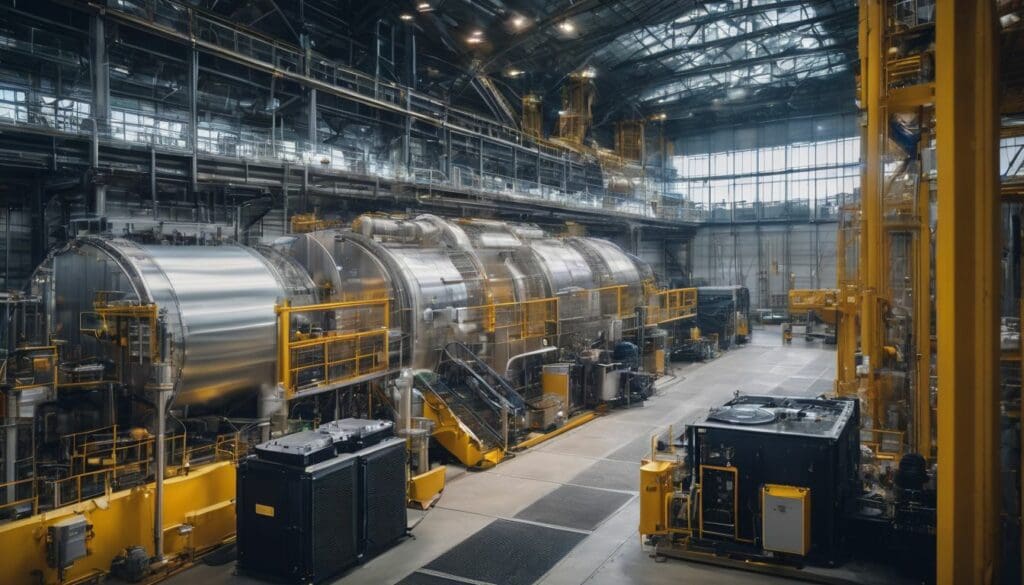Is the future of energy shimmering on the horizon, or is hydrogen just a fleeting fancy? We’ve all pondered whether this much-vaunted element truly holds the key to powering our tomorrows.
Having delved into the depths of this subject, we’ve discovered that hydrogen’s lower radiant heat compared to traditional fuels presents us with an intriguingly safer alternative.
Our investigation illuminates how hydrogen has the potential to spark a transformation in our energy landscape or simply peter out as a mere flash in the pan. Make sure you’re clued up on the ins and outs—this is one revelation you won’t want to miss!
Key Takeaways
- Hydrogen is gaining attention as a potential clean energy source, with technologies advancing and demand for sustainable alternatives rising.
- There are different types of hydrogen – blue, grey, brown, pink and green – each with distinct production methods and environmental impacts; green hydrogen is the most eco-friendly option.
- Although hydrogen has the potential to reduce greenhouse gas emissions in industries that are hard to decarbonise, its production can still lead to significant emissions if not managed correctly.
- High costs of green hydrogen production and questions around efficiency pose challenges for its widespread adoption; investment in technology and infrastructure development is essential.
- The role of hydrogen in a decarbonised future looks promising but requires strategic advancement to overcome current barriers related to cost-effectiveness and existing infrastructure.
Understanding the Hype Around Hydrogen
The growing hype around hydrogen is driven by advancements in technology and the increasing demand for cleaner energy sources. It also holds potential as a storage medium for renewable energy, making it an attractive option for a sustainable future.
Advancements in technology and demand for cleaner energy sources
We’re seeing a surge in cleaner energy technologies, and hydrogen is grabbing the spotlight. It’s like unlocking a new level in our quest for sustainable energy solutions. Our tools are getting better, smarter, and more efficient.
They now make it possible to harness hydrogen as a potent fuel that could power our future without leaving behind a trail of carbon emissions.
Companies and researchers are racing to innovate ways to produce, store, and use hydrogen effectively. We want cars that emit nothing but water vapour from their tailpipes. Imagine plugging in your electric car or even your home to a clean source of energy generated from hydrogen fuel cells! The demand for zero-emission vehicles and carbon-neutral energy sources is driving this push forward – making us all players in shaping an environmentally friendly game board for generations to come.
Potential as a storage medium for renewable energy
As a storage medium for renewable energy, hydrogen offers promising potential. It can be produced by using excess electricity from renewable sources to electrolyse water, creating green hydrogen that can be stored in fuel cells or tanks until needed.
This means that hydrogen has the capability to store and release energy as required, making it a flexible solution for the intermittent nature of renewable energy sources like wind and solar power.
Furthermore, this could contribute towards the overall goal of decarbonisation within the energy sector, offering a clean alternative to fossil fuels.
The Different Types of Hydrogen
There are various types of hydrogen, including blue, grey, brown, pink, and green. Each type has a different production process and carbon footprint. Understanding these differences is essential in evaluating the potential of hydrogen as a clean fuel for the future.
Blue, grey, brown, pink, and green hydrogen
Blue, grey, brown, pink, and green hydrogen are the different types of hydrogen distinguished by their production processes and environmental impact. Blue and grey hydrogen are produced from natural gas with carbon capture or without it respectively, while brown hydrogen is manufactured through coal gasification.
Pink hydrogen is an experimental type generated using nuclear power, and green hydrogen comes from renewable energy sources such as wind or solar power. Each type varies in terms of emissions produced during production and its potential for supporting a cleaner energy future.
The distinctions between these types of hydrogen highlight the need to carefully evaluate their environmental impact and consider their role in reducing greenhouse gas emissions. We must weigh the benefits and challenges associated with each type to determine their viability as alternative fuels for a sustainable future.
Climate Impact of Hydrogen Production
Hydrogen production is associated with greenhouse gas emissions, but it also holds the potential to reduce emissions in hard-to-abate industries; learn more about the environmental impact and potential of hydrogen fuel.
Greenhouse gas emissions from production
Hydrogen production can generate greenhouse gas emissions through various methods, particularly when it involves the use of fossil fuels. For instance, grey and brown hydrogen production processes release significant amounts of carbon dioxide into the atmosphere.
Additionally, blue hydrogen is produced using steam methane reforming with carbon capture and storage, a process that also generates emissions. It’s important to note that the environmental impact varies depending on the type of hydrogen being produced.
Green hydrogen production stands out as a promising alternative in terms of reducing greenhouse gas emissions. This method utilises renewable energy sources to power electrolysis, resulting in no direct carbon emissions during the production process.
Potential for reducing emissions in hard-to-abate industries
Industries with challenging emissions can benefit from hydrogen. Its potential for reducing emissions in hard-to-abate sectors such as steel and cement production is substantial. By replacing traditional high-emission fuels, hydrogen offers a pathway to significantly cut down industry-related greenhouse gas releases.
Moreover, incorporating hydrogen into these industries also aligns with the global push towards sustainable energy sources and climate change mitigation.
Innovations in utilising hydrogen have shown promising results in dealing with hard-to-abate industrial emissions. The integration of green hydrogen production methods could further enhance its contribution to emission reduction efforts across various sectors, improving the environmental sustainability of industrial processes.
Challenges and Criticisms of Hydrogen Fuel
Despite its potential, hydrogen fuel faces challenges such as cost and efficiency concerns, as well as limited infrastructure and technology. To understand more about the pros and cons of using hydrogen as a clean fuel for the future, keep reading!
Cost and efficiency concerns
Green hydrogen production is currently more expensive and energy-intensive than traditional methods, making it less efficient for widespread use. The high cost of electrolysers, which are used to produce green hydrogen from water electrolysis using renewable electricity, adds to the expense.
Additionally, the limited availability of infrastructure for hydrogen storage and transportation further hampers its efficiency as a fuel option. Despite efforts to drive down costs through technological innovation and increased investment in the industry, these concerns remain significant barriers to widespread adoption.
The efficiency of hydrogen fuel cells can also be a concern, as converting the energy stored in hydrogen gas into electricity can result in energy losses. This means that while using hydrogen as a clean fuel source holds promise for decarbonising various industries and applications such as transportation, addressing these cost and efficiency concerns will be pivotal in realising its full potential as an alternative fuel option.
Limited infrastructure and technology
Hydrogen fuel faces challenges due to limited infrastructure and technology. This includes:
- Insufficient refueling stations
- Inadequate hydrogen production facilities
- Lack of widespread distribution networks
- Limited availability of hydrogen – powered vehicles
- Technological barriers in storing and transporting hydrogen efficiently
- Need for advancements in fuel cell technology for wider application
- Challenges in integrating hydrogen into existing energy systems
The Role of Hydrogen in a Decarbonised Future
Hydrogen has the potential to play a crucial role in a decarbonised future, as it can be used for clean energy production and fueling transportation. To learn more about the different types of hydrogen and its impact on climate change, keep reading our blog!
Potential for clean energy production and fueling transportation
Hydrogen holds promise as a clean energy source for the future, offering zero-emission vehicles and carbon-neutral energy. It can be used in fuel cells to produce electricity, water, and heat, making it versatile for various applications.
The potential of green hydrogen as a renewable energy source is being closely evaluated by experts. However, careful consideration and investment are necessary to harness its full potential.
Moving forward to “Need for careful consideration and investment in the industry,” let’s explore the essential factors that pave the way for effective utilisation of hydrogen technology.
Need for careful consideration and investment in the industry
Investing in the hydrogen industry requires careful consideration due to its potential as a renewable, zero-emission energy source. Assessing the environmental impact and technological advancements is crucial for making informed decisions.
The industry demands rigorous evaluation of green hydrogen production methods and infrastructure development to leverage its full potential as a sustainable fuel option. Research into efficient storage solutions and advancements in fuel cell technology is essential for establishing hydrogen’s role in powering zero-emission vehicles and decarbonising hard-to-abate industries.
Careful investment in innovation and infrastructure will drive the growth of the hydrogen economy, providing clean energy options for transportation, power generation, and industrial applications.
Conclusion
In conclusion, the debate over hydrogen as a clean fuel is ongoing. We must carefully consider its potential environmental impact and role in renewable energy. Investing in infrastructure and technology could pave the way for a decarbonised future.
It is crucial to critically evaluate the hype surrounding hydrogen and make informed decisions about its place in our clean energy future.
FAQs
1. What is the Hydrogen Hype all about?
The Hydrogen Hype surrounds the idea that hydrogen could be a zero-emission, green fuel technology alternative for the future, aiming to reduce greenhouse gases.
2. Can hydrogen be used as an energy storage method?
Yes, hydrogen has potential as an energy storage solution, especially when it’s produced from carbon-neutral energy sources and used in zero-emission vehicles.
3. Is hydrogen truly a clean fuel option for the environment?
Hydrogen can be considered clean if it’s produced without emitting greenhouse gases; this makes its environmental impact assessment favourable for being a green alternative fuel option.
4. How does hydrogen compare to other alternative fuels regarding emissions?
When discussing zero emissions, hydrogen stands out among alternative fuels because when used in vehicles or other applications, it produces no greenhouse gases.





